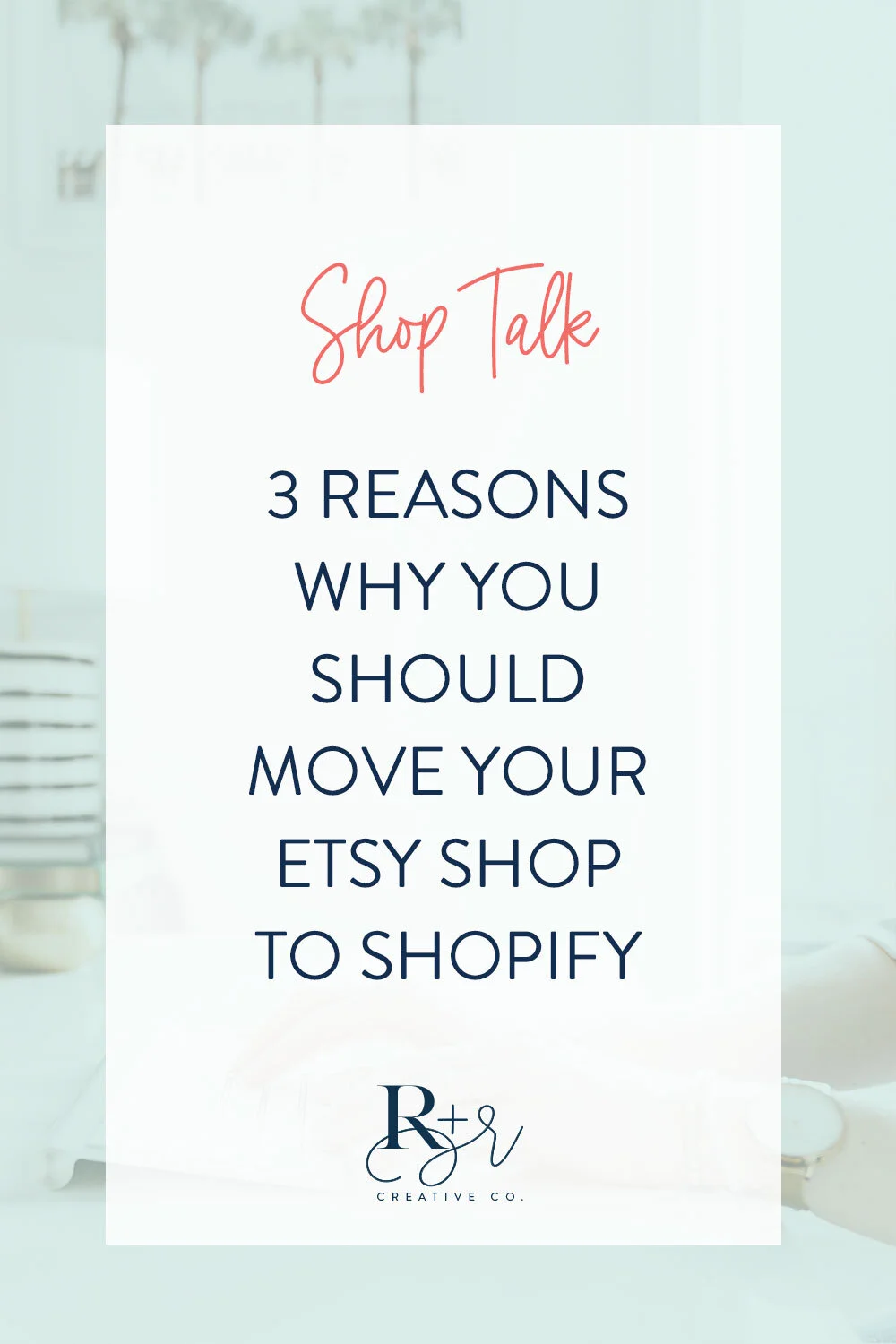3 Reasons Why You Should Move Your Online Shop To Shopify
Why move your shop to Shopify? 3 key reasons why our clients have chosen to move from Etsy to Shopify and why you might consider it too.
There are several options out there that can help you create an online shop for your business, hobby, or extra revenue stream. After helping several clients set up their online shops, migrate shops from one platform to another, and maintaining shops, one thing is clear: We love Shopify! Shopify is an amazing tool for most product based businesses and gives you as a shop owner several key advantages over an online marketplace like Etsy.
Many of our clients started out with Etsy but then came to us asking about alternatives once they started feeling that they wanted more control over their brands and shops and felt ready to take the next step in their business journey. When a client comes to us about this, we first take a look at why they want to do this and see if we can recommend a solution that best fits them and their business. Is it because they want to control how their brand looks? Is it because they want something easier to use than what they already have? Most of the time, Shopify has been the solution for them!
There are a few reasons why we feel they should move to Shopify and we’re sharing them here with you!
#1: Your Shop Can Fully Reflect Your Brand
“Where did you buy that?”
“I bought it on Etsy!”
When you spend so much time, money and effort building your brand and making sure it is seen the right way by your customers, and they say that when they buy your products, it’s so easy to feel defeated! You don’t want them to say “I bought it on Etsy”, you want them to say I bought it at {Insert Your Shop Name Here} right?
Your logo, your color scheme, and your voice are all critical factors of your brand identity and affect how your brand is perceived by your customers. When you have a shop on Etsy, you are using Etsy’s menus, their navigation, and their customer experience. Also, brand recognition is difficult on Etsy because there are thousands of shops in the same marketplace, often selling similar products. Shoppers don’t often differentiate between one shop and another, thus the dreaded “I bought it on Etsy” comment. Your products are shown next to other sellers products even within your own shop in a “similar products” section underneath your listing. It is definitely not easy to stand out in a crowded online marketplace like Etsy.
On Shopify, you are able to customize every part of the customer experience and there are no other shops competing for your a shopper’s attention when they are on your site. You can prominently feature your logo, your products, and your customer service style. You can control your customer’s experience while they are shopping on your own site. This will help create the brand recognition that all shop owners want and keep your customers coming back to you.
#2: Your Shop is Your Shop and Your Customers are Your Customers
Your Shopify site runs on Shopify’s platform but you own it. You are in charge of what you offer, how much you charge and your customer journey. With Etsy, you don’t own your shop and you are forced to make changes when they decide to make changes, not when you feel it is right.
In 2019, for example, Etsy said that only shops who offer free shipping will be featured on their site, basically requiring all shops to offer free shipping. Depending on what you sell, shipping can be a costly part of your offering and it’s not so easy to include it in your pricing without pricing yourself out of the market. Many shop owners were forced to raise their prices to continue to keep their profit margins healthy. For many businesses, product pricing is tricky and takes into account several factors such as material costs and time spent to create the product. These are things that a seller can control for the most part. Shipping is a variable controlled by external forces. So, requiring a company to ship for free can hurt a business and takes away choice. With a shop on Shopify, you as the seller can make these choices depending upon what works best for your business.
Other than making some business decisions for you, one of the most important things that should convince you to make the switch is that the customers you get on Etsy actually ‘belong’ to Etsy. Etsy requires that you communicate with your customers about their transaction, but that is all. That means that you can’t add them to your email list or email them about any promotions. The only way to add them to your list is if they voluntarily add themselves via your other channels, such as through a freebie that you are offering on your own website or through a social media promotion. With Shopify, you own your customers’ information. You can build a database of customers that you can contact and send newsletters and shop updates to when it makes sense for you. Note: You do still have to get your customers’ permission for this, as required by law, but it is a much more streamlined option. They can opt-in while they are already on your site or on your checkout page.
#3: Shopify only does shops
Focusing on one thing and doing it really well has its advantages. Shopify only does shops and they do them extremely well. There are a large variety of types of shops that run on Shopify, so they are focused on being able to provide the right tools for all of those different types of shop needs. Shopify has everything you need to run your shop and doesn’t get distracted by other online services. They make it easy for you to set up, manage the items in your shop yourself, and get things done on your shop without the need for a web developer. They create a great user experience without any need to know code! Their customer service is also very responsive and it doesn’t take long to get an answer to your questions. We have found their support to be comprehensive and accessible - you can contact them 24/7 by email, live chat or phone. This is significantly better than the support options offered by some other competitors!
In case those aren’t enough reasons, here are a few other factors to consider when choosing a shop platform and why we feel Shopify excels in these areas:
Interface: The Shopify interface for you as a shop owner is clean, straightforward, and easy to understand. Even more important is that the customer experience on your shop, whether on a desktop or mobile device, is also clean, straightforward and easy to navigate.
Customization & expansion options: Shopify allows for customization of your template design, customer experience and even allows for third-party developer apps that can make your shop experience a great one for your customers to be installed on your site. As a result, you can easily overcome some out-of-the-box limitations that Shopify has (like the number of variants for a product), integrate social media add-ons (like Instagram shopping), and add dropshipping connections with minimal additional effort and cost.
Customer interactions: Unlike with Etsy, Shopify allows you to be in control of how your customer interacts with your site and how you interact with your client. One example of this is their abandoned cart feature, which allows you to either view a list of people who have abandoned their carts and manually send them a message or you can have Shopify automatically send a message to visitors who have abandoned their carts, often resulting in a higher amount of sales, as research shows that most people who abandon their carts are likely to come back and buy those items in their cart if they are reminded about it.
SEO: Similar to other platforms, Shopify allows you to easily manage your SEO. You have full control over your page titles and meta descriptions, they encourage the use of things like headings and page descriptions, and they allow you to customize the alt text and names of your images. Additionally, if you change a page name, Shopify proactively prompts you to create a redirect so that your customers can still easily find that page if they had it bookmarked.
Mobile: Most Shopify templates are mobile-responsive and we have only heard positive feedback from Shopify clients when it comes to their customers interacting with their shops via a mobile device. Also, the Shopify app is great when it comes to managing your shop via your phone. You can easily add products and check on orders through their app and it even makes a satisfying “Ka-Ching” sound when someone makes a purchase on your shop!
The Cons
There are definitely great reasons for using Shopify, however it’s not all a bed of roses. If you are just starting out, don’t yet have a defined brand, and are selling handmade goods, then being on Etsy can work well for you. Etsy has a built-in marketplace for handmade sellers that can make it easier to get customers and be discovered. With Shopify, you have to drive your own traffic to your shop. If you have a solid marketing plan or a lot of good customers who can spread your name through word of mouth, then this won’t be an issue for you as you can easily drive traffic to your shop.
The costs: Shopify’s standard plan starts at $29/per month. That price may go up depending upon if you need to add apps to your shop that help you run it easier. Many apps are free, but many others are not. This adds to the monthly fee. However, online marketplaces like Etsy also have their own set of charges that may add up to be more. It’s important to know your profit margins and what is best for you and your business!
Summary
In our experience, shop owners are excited to move to Shopify but sometimes like to keep their products on both platforms for a few months before being fully committed to just Shopify. It’s important to look at what you are currently offering and where you wish to be before deciding on switching platforms.
Interested in discussing any of the above or getting some help? Please let us know or schedule a no-obligation call with us to discuss your thoughts. If you want to give Shopify a try, use this (affiliate) link to get a 90-day free trial!
Ready to launch your Shopify shop?
Download our Shopify Launch Checklist now! Our checklist is based on years of Shopify experience and includes all of the important behind-the-scenes items you need to check off to make sure your shop launches smoothly! Enter your email address below to get it now.


